Die Siedler von Catan - Deutschland Edition
Author: Klaus Teuber
Publisher: Kosmos
Year: 2008
review by

| x |
|
|
|
|
|
|
|
|
|
|
|
|
|
|
|
|
|
|
|
|
|
|
|
|
|
|
|
|
|
|
|
|
|
|
|
|
|
|
|
|
|
|
|
|
|
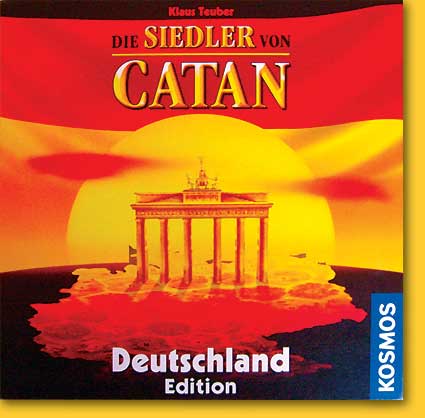 |
Since their appearance the Settlers of Catan have ecountered all kinds of adventures; they have stood out to sea, fought against barbarians and visited the pyramids; travelled with Alexander the Great and even colonised space, but now, at last, they settle where they really feel theirselves at home: in Germany. ‘Die Siedler von Catan - Deutschland Edition’ can be played independantly with no need for any other Settlers game, and after so many years after the first appearance of the ‘basic’ game and the elapse of nearly a generation we feel the need to describe this ‘Deutschland Edition’ version in detail; the Catan connoisseur then automatically sees where ‘Die Siedler von Catan - Deutschland Edition’ differs from ‘his’ Catan. |
| x |
|
|
|
|
|
|
|
|
|
|
|
|
|
|
|
|
|
|
|
|
|
|
|
|
|
|
|
|
|
|
|
|
|
|
|
|
|
|
|
|
|
|
|
|
|
| The goal of the game is to gain points by building town halls and landmarks: ten points in a four player game, twelve with three players; the player who can claim these points has won the game. Each player is blindly dealt a card with three different starting positions on it; he may freely place a town hall here, and as a town hall is worth one point, the first three points come easy! The starting card also states which two resource cards a player gets; these are different for each of the players. |
|
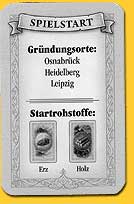 |
| x |
|
|
|
|
|
|
|
|
|
|
|
|
|
|
|
|
|
|
|
|
|
|
|
|
|
|
|
|
|
|
|
|
|
|
|
|
|
|
|
|
|
|
|
|
|
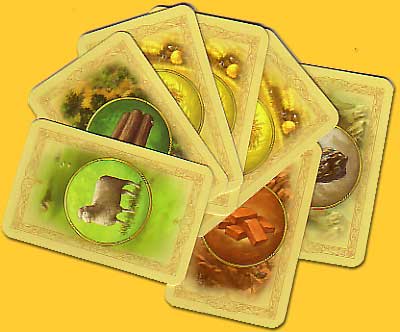 |
These resources are needed for building; a town hall for instance requires one wool, a clay, a grain, and one wood. But how to get to these resources? In his turn, a player first throws two dice; the result is added and now each player checks if this number is on a field adjacent to one of his town halls; if so, the player may take the resource card for each town hall that is adjacent to this field. This way players may acquire resources even when it is not their turn!
The numbers on the fields are printed in varying sizes; this is to state the chance a number will be rolled; the chance for an ‘8’ or a ‘5’ is considerabley higher than for a ‘2’ or a ‘12’. |
| x |
|
|
|
|
|
|
|
|
|
|
|
|
|
|
|
|
|
|
|
|
|
|
|
|
|
|
|
|
|
|
|
|
|
|
|
|
|
|
|
|
|
|
|
|
|
After this the active player may build; when he has the neccessary resources for a town hall, he puts them back in the supply and places a town hall on the board. This however is only allowed at the specified city fields, and only if a player has connected this field with one or more roads originating from an existing town hall in his colour. And building roads cost resources too: one wood and one brick per road. Happily more items may be built at a time, so with two wood and two brick two roads can be built. When a player has the required resources , he may build the town hall as well.
The choice where to build a town hall may be influenced by the type of fields adjacent to a city; these possibly produce the wanted resources. So if a player does not have a town hall with an adjacent grain field already, this could be an attractive location to build, dependent on the chance the dice will ‘hit’ this field. |
|
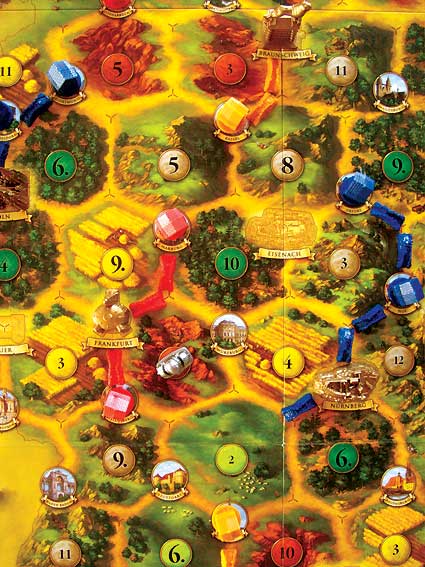 |
| x |
|
|
|
|
|
|
|
|
|
|
|
|
|
|
|
|
|
|
|
|
|
|
|
|
|
|
|
|
|
|
|
|
|
|
|
|
|
|
|
|
|
|
|
|
|
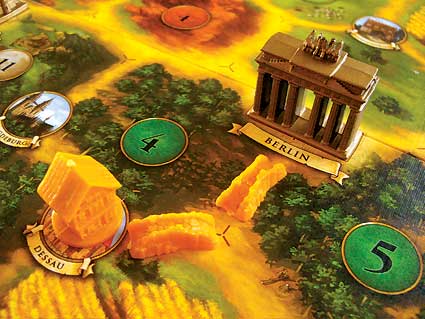 |
|
The building of landmarks - costs: two iron and a grain - also is rewarding; although there are no gains for the adjacent fields, building a landmark earns one victoy point; on the empty field of the landmark at the edge of the board a player places a town hall to indicate his victory points. |
| x |
|
|
|
|
|
|
|
|
|
|
|
|
|
|
|
|
|
|
|
|
|
|
|
|
|
|
|
|
|
|
|
|
|
|
|
|
|
|
|
|
|
|
|
|
|
| When built, a player gets a one time bonus as stated next to the landmark. This may vary from building a free road to receiving two resources or a development card - we get to these in a moment. |
|
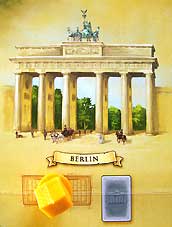 |
x |
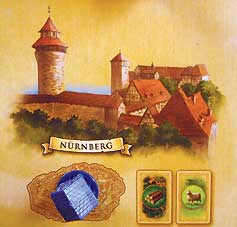 |
|
| x |
|
|
|
|
|
|
|
|
|
|
|
|
|
|
|
|
|
|
|
|
|
|
|
|
|
|
|
|
|
|
|
|
|
|
|
|
|
|
|
|
|
|
|
|
|
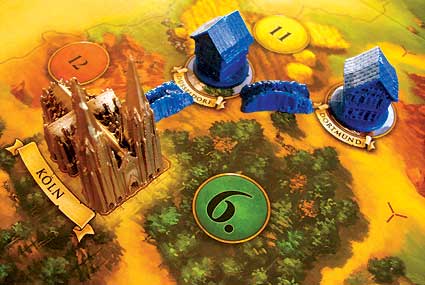 |
|
But what if a player does not have the right resources? Let’s say he has three grain, an iron and two wood cards in his hand. To build a town hall, he lacks a wool, and to build a landmark he lacks an iron. Fortunately an active player may trade resources with other players. Say, the player decides he wants to build a town hall, so he asks the other players if they have a wool for him. One player has one, but wants a grain and a wood in exchange for it.
Another player interrupts: he also has a wool, but only wants a wood in exchange. This is a bargain, so the deal is made. The active player now pays the required resources and places his town hall on the board. Only an active player may initiate a trade. |
| x |
|
|
|
|
|
|
|
|
|
|
|
|
|
|
|
|
|
|
|
|
|
|
|
|
|
|
|
|
|
|
|
|
|
|
|
|
|
|
|
|
|
|
|
|
|
| Sometimes no deal can be made; the players do not have the required resources or need them theirselves, or have an other reason why not to do business with the active player, for instance when this player is only one or two points away from the victory condition. But an active player may at any time trade three similar resources against one other resource with the supply, say: the bank. |
| x |
|
|
|
|
|
|
|
|
|
|
|
|
|
|
|
|
|
|
|
|
|
|
|
|
|
|
|
|
|
|
|
|
|
|
|
|
|
|
|
|
|
|
|
|
|
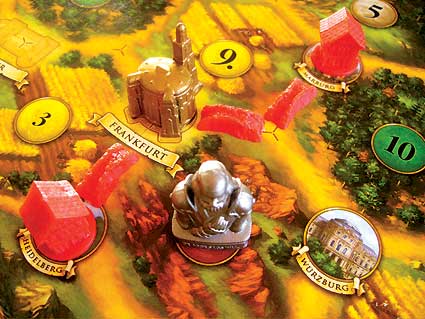 |
|
Of course a player can wait until he has all of the neccessary resources through dice rolls, but collecting is not encouraged as with each rolled ‘7’ all players with more than seven resource cards in their hand have to discard half of these. When a ‘7’ is rolled, the active player places a general token to any field of his choice; if there is a town hall of another player adjacent to this field he may blindly draw a resource card from this players hand and add it to his own hand. This token, represented in this ‘Germany’ game by the historical Götz von Berlichingen, a famous German robber knight, blocks the profits from the field it is on |
| x |
|
|
|
|
|
|
|
|
|
|
|
|
|
|
|
|
|
|
|
|
|
|
|
|
|
|
|
|
|
|
|
|
|
|
|
|
|
|
|
|
|
|
|
|
|
During the building phase a player also may buy development cards; these cost a wool, an iron and a grain. The cards can be used in a later turn; they do not count against a players hand when a ‘7’ is rolled.
These development cards come in three kinds: mercenary cards that may move the ‘Götz’ token and perform the action that goes with it; progression cards that themselves come in three flavours: place two roads for free, take two free resources, or trade two to one during any single turn. And finally there is the occasional development card that shows a victoy point. These cards are kept face down until use.
|
|
 |
x |
 |
|
| x |
|
|
|
|
|
|
|
|
|
|
|
|
|
|
|
|
|
|
|
|
|
|
|
|
|
|
|
|
|
|
|
|
|
|
|
|
|
|
|
|
|
|
|
|
|
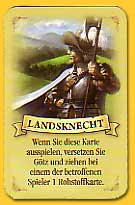 |
Buying a development card is a nice alternative action when a player does not have the required resources for a town hall or a landmark but still wants to take a chance in this card tombola. The mercenaries, once played, are kept face up. When a player is the first to have three played mercenaries, he may claim the largest army ‘Größtes Heer’ at the edge of the board and place a town hall there, again one point! Any other player only can claim this position if he has more played mercenary cards. |
| x |
|
|
|
|
|
|
|
|
|
|
|
|
|
|
|
|
|
|
|
|
|
|
|
|
|
|
|
|
|
|
|
|
|
|
|
|
|
|
|
|
|
|
|
|
|
The same goes for the longest trade route: when a player has five connected roads, with no twinings, he may claim the position ‘longest trade route’ at the edge of the board and place a town hall. When building roads a player only may build beyond a town when he has build the town hall for the city; this also goes for the landmark; only here it does not matter who built it, any player may build a road beyond the landmark.
When a player has reached the necessary points, including any points from his development cards, he has won the game. |
|
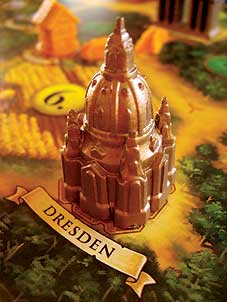 |
| x |
|
|
|
|
|
|
|
|
|
|
|
|
|
|
|
|
|
|
|
|
|
|
|
|
|
|
|
|
|
|
|
|
|
|
|
|
|
|
|
|
|
|
|
|
|
| x |
|
|
|
|
|
|
|
|
|
|
|
|
|
|
|
|
|
|
|
|
|
|
|
|
|
|
|
|
|
|
|
|
|
|
|
|
|
|
|
|
|
|
|
|
|
| x |
|
|
|
|
|
|
|
|
|
|
|
|
|
|
|
|
|
|
|
|
|
|
|
|
|
|
|
|
|
|
|
|
|
|
|
|
|
|
|
|
|
|
|
|
|
 |
|
|
|
|
|
|
|
|
|
|
|
|
|
|
|
|
|
|
|
|
|
|
|
|
|
|
|
|
|
|
|
|
|
|
|
|
|
|
|
|
|
| The charm of àll Catan versions is that all players are involved in the game, even outside their turn. This starts when the dice are thrown; the result might be of interest to every player: oh, I get a grain, and I two wood! Besides this there is the trade phase where the active player tries to get to wanted resources and this also results in much player interaction. |
| x |
|
|
|
|
|
|
|
|
|
|
|
|
|
|
|
|
|
|
|
|
|
|
|
|
|
|
|
|
|
|
|
|
|
|
|
|
|
|
|
|
|
|
|
|
|
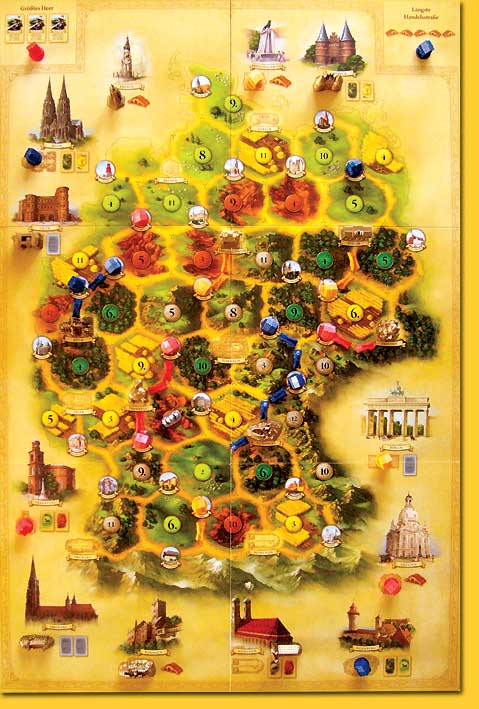 |
| x |
|
|
|
|
|
|
|
|
|
|
|
|
|
|
|
|
|
|
|
|
|
|
|
|
|
|
|
|
|
|
|
|
|
|
|
|
|
|
|
|
|
|
|
|
|
‘Die Siedler von Catan - Deutschland Edition’ has a lower entry level than the ‘basic’ game ‘The Settlers of Catan’: players have fixed starting positions so no thinking is involved where to put the houses at the start of the game, and other tactical decisions are minimised as there are no harbours in the game: every player can trade three resources against one. The cities have been replaced by landmarks and have a reduced price: two grain less! The requirement from the original game to build a village or city at least two roads apart does not have to be remembered as all possible positions are preprinted.
All this makes the game even easier to play for the unexperienced player than ‘The Settlers of Catan’ already was, and it also results in less playing time. Despite the fact that the game is not meant for two players, it plays surprisingly well, but the heart of the game, the trading, falls silent here. |
| x |
|
|
|
|
|
|
|
|
|
|
|
|
|
|
|
|
|
|
|
|
|
|
|
|
|
|
|
|
|
|
|
|
|
|
|
|
|
|
|
|
|
|
|
|
|
| And then we even haven’t mentioned the appearance of the landmarks: what a delightfully detailed miniatures! These are a true delight to look at. ‘Look at this nice/strange/odd/distinct landmark! We must go see it some time!’ |
|
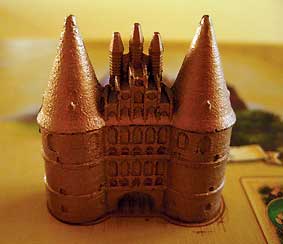 |
| x |
|
|
|
|
|
|
|
|
|
|
|
|
|
|
|
|
|
|
|
|
|
|
|
|
|
|
|
|
|
|
|
|
|
|
|
|
|
|
|
|
|
|
|
|
|
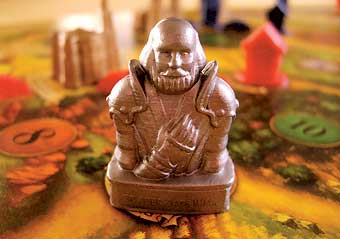 |
Placing ‘Götz’ on a field where an other player has his town hall goes with a high ‘take that’ sentiment, and the ones involved in producing the game have realised this by putting a to Götz related quote on the token, but not quite finishing it: ‘Er aber sag’s ihm...’ (’But he, tell him...’). In a play written by Goethe and dedicated to Götz von Berlichingen the famous quote as it happens continues: ‘...er kann mich im Arsche lecken!’ (’...he may kiss my ass!’). Who wants to know who the adressed was must read the play; we rather play a game or two, three and more instead! People who think this all is too uncultivated and bad taste are advised to listen to the two canons 231 and 382d by Mozart, respectively titled ‘Leck mich am Arsch’ (kiss my ass) and ‘Leck mir den Arsch schon recht schön sauber’ (really kiss my fine ass)! |
| x |
|
|
|
|
|
|
|
|
|
|
|
|
|
|
|
|
|
|
|
|
|
|
|
|
|
|
|
|
|
|
|
|
|
|
|
|
|
|
|
|
|
|
|
|
|
| Some criticism remains: when the game has reached the end phase, that is: when a player has only one point to go to win, the game can get sluggish. No other player will want to trade with this player, as he could give away victory. The player will have to be content with the dice rolls to get his last point. Meanwhile this gives the other players the opportunity to get in an equal position, after which they also are dependent from the whimsical dice rolls. This leads to the repetitive sequence: throwing: nope: next player - throwing: nothing: next!, and so on. This way the game unintentionally sags to an ordinary dice game. |
|
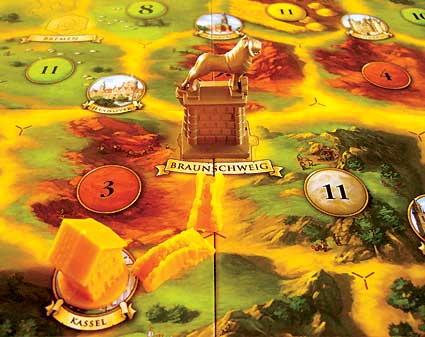 |
| x |
|
|
|
|
|
|
|
|
|
|
|
|
|
|
|
|
|
|
|
|
|
|
|
|
|
|
|
|
|
|
|
|
|
|
|
|
|
|
|
|
|
|
|
|
|
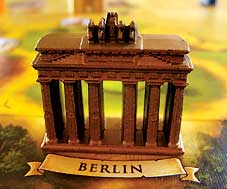 |
|
What more is there to say? After so many years ‘Die Siedler von Catan - Deutschland Edition’ in fact could be called the new standard Catan game: short, simple but yet challenging, and very very nicely produced!
© 2009 Richard van Vugt
Die Siedler von Catan - Deutschland Edition, Klaus Teuber, Kosmos, 2008 - 3 or 4 players, 10 years and up, 60-90 minutes
|
| x |
|
|
|
|
|
|
|
|
|
|
|
|
|
|
|
|
|
|
|
|
|
|
|
|
|
|
|
|
|
|
|
|
|
|
|
|
|
|
|
|
|
|
|
|
|
Adjusted end phase - variant
|
| When a player is only one visible point from victory, a (third) die is set on the '1' and put in front of this player. Each turn, the die is set one point higher. When the die reaches the '4', that player has won if he could not already claim victory earlier through regular building or victory point cards. When there is a second player with only one point holding him from victory, the die moves to this player and regardless of the current setting the die is set to '2'. Again, that player has won when at the start of his turn the die is moved to the '4'. If there is a third player before this happens, the die is set to '3'. A fourth player reaching the one point lacking condition has won automatically. |
|
| x |
|
|
|
|
|
|
|
|
|
|
|
|
|
|
|
|
|
|
|
|
|
|
|
|
|
|
|
|
|
|
|
|
|
|
|
|
|
|
|
|
|
|
|
|
|
| x |
|
|
|
|
|
|
|
|
|
|
|
|
|
|
|
|
|
|
|
|
|
|
|
|
|
|
|
|
|
|
|
|
|
|
|
|
|
|
|
|
|
|
|
|
|
  |
|
|
|
|
|
|
|
|
|
|
|
|
|
|
|
|
|
|
|
|
|
|
|
|
|
|
|
|
|
|
|
|
|
|
|
|
|
|
|
|
|
  |
|
|
|
|
|
|
|
|
|
|
|
|
|
|
|
|
|
|
|
|
|
|
|
|
|
|
|
|
|
|
|
|
|
|
|
|
|
|
|
|
|
  |
|
|
|
|
|
|
|
|
|
|
|
|
|
|
|
|
|
|
|
|
|
|
|
|
|
|
|
|
|
|
|
|
|
|
|
|
|
|
|
|
|
  |
|
|
|
|
|
|
|
|
|
|
|
|
|
|
|
|
|
|
|
|
|
|
|
|
|
|
|
|
|
|
|
|
|
|
|
|
|
|
|
|
|
| x |
|
|
|
|
|
|
|
|
|
|
|
|
|
|
|
|
|
|
|
|
|
|
|
|
|
|
|
|
|
|
|
|
|
|
|
|
|
|
|
|
|
|
|
|
|
| x |
|
|
|
|
|
|
|
|
|
|
|
|
|
|
|
|
|
|
|
|
|
|
|
|
|
|
|
|
|
|
|
|
|
|
|
|
|
|
|
|
|
|
|
|
|
 |
|
|
|
|
|
|
|
|
|
|
|
|
|
|
|
|
|
|
|
|
|
|
|
|
|
|
|
|
|
|
|
|
|
|
|
|
|
|
|
|
|
 |
|
|
|
|
|
|
|
|
|
|
|
|
|
|
|
|
|
|
|
|
|
|
|
|
|
|
|
|
|
|
|
|
|
|
|
|
|
|
|
|
|
| x |
|
|
|
|
|
|
|
|
|
|
|
|
|
|
|
|
|
|
|
|
|
|
|
|
|
|
|
|
|
|
|
|
|
|
|
|
|
|
|
|
|
|
|
|
|
 |
|
|
|
|
|
|
|
|
|
|
|
|
|
|
|
|
|
|
|
|
|
|
|
|
|
|
|
|
|
|
|
|
|
 |
|
|
|
|
|
|
|
|
|
|
|
|
|
|
|
|
|
|
|
|
|
|
|
|
|
|
|
|
|
|
|
|
|